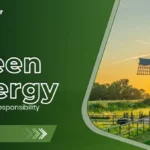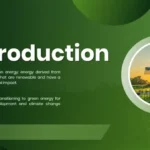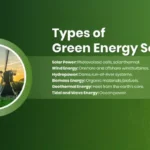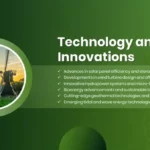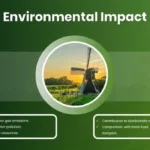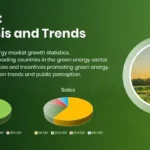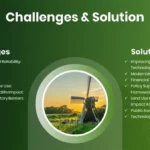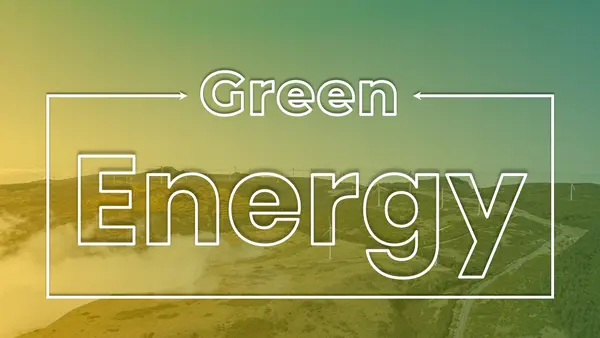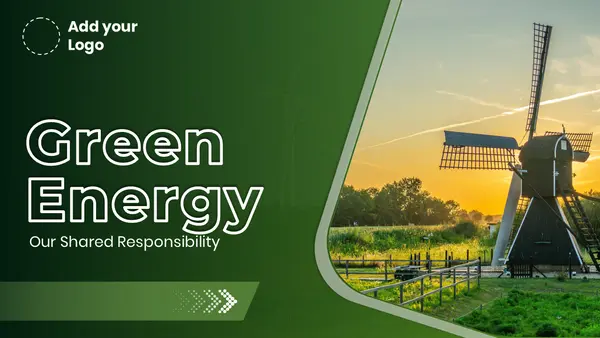Green Energy Templates
Get Ready to captivate your audience with our comprehensive Power of Green Energy Templates! We’ve designed a versatile set of slides available in PowerPoint, Canva, and Google Slides formats, perfect for any Cause whether you’re presenting at your institution, or company, or aiming to impress potential investors.
Our fully customizable templates allow you to effortlessly adjust colors, images, fonts, and icons with just a few clicks.
Let’s dive into each slide to uncover their unique benefits and discover how they can make your presentation on green energy truly impactful.
Introduction to Green Energy (Slide 06)
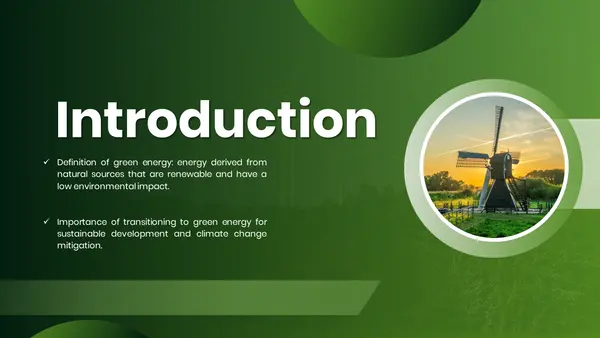
This slide of the Green Energy template briefly introduces and defines the urgency of addressing climate change and the role of green energy. This slide also highlights the importance of transitioning to green energy.
- a) Definition of Green Energy
Green energy refers to sustainable, renewable energy with minimal harmful consequences on the ecosystem. This is in contrast to fossil fuels, which discharge significant degrees of greenhouse gases and pollutants originating from natural phenomena that renew themselves. These sources involve solar light, wind, and Water. biological substances and geothermal heat are essential to decrease our carbon and reduce climate change.
- b) Importance of Transitioning to Green Energy
Shifting to green energy is essential in terms of various factors. To begin with, it helps fight global warming by reducing greenhouse emissions that are major contributors to global warming. Secondly, green energy supports energy independence by varying energy sources and reducing dependence on imported fossil fuels. Finally Promotes economic growth using employment generation within new industries and reduces health risks related to pollution originating from conventional energy sources.
This slide of the Green Energy template will help you set up the stage for the presentation by highlighting the importance of the topic along with engaging the audience with a clear statement of the presentation’s focus.
Green Energy Source Types (Slide 07)

This slide of the Green Energy Template contains various types of green energy sources.
There are different types of green energy, each with special qualities and uses. The most typical kinds consist of:
- Sunlight Power
Solar energy uses sun-powered warm and photovoltaic gadgets to capture sun-based radiation. Sun-based warm frameworks utilize the warmth from the sun to make power, while photovoltaic cells specifically turn daylight into power. Sun-oriented energy is getting to be more and more reasonable, copious, and sustainable.
- Wind Power
Converting the active energy of wind into electricity utilizing wind turbines is how wind energy is produced. Wind ranches, both on land and at the ocean, have ended up being a critical source of renewable energy, especially in locales with reliable wind patterns.
- Hydroelectricity
Using the energy of streaming water to make power is Hydroelectricity. It is one of the most considerable and widely used sources of clean energy. Both larger hydropower facilities and smaller micro-hydropower setups add to the world’s supply of renewable energy.
- Energy from Biomass
Plant and animal waste are examples of organic materials that can be converted into biomass energy. It can be transformed via procedures including gasification, anaerobic digestion, and combustion into heat, energy, or biofuels. Because of its flexibility, biomass energy can be created from a variety of sources, such as forestry byproducts and agrarian leftovers.
- Thermal Energy
Utilizing the heat from the Earth’s center, geothermal energy produces heat and control. This is a tried and true and feasible energy source, particularly in zones where geothermal movement is high.
- Wave and Tidal Power
Utilizing the inherent motions of water, tidal and wave energy produces electricity. For tidal energy to exist, there is a rise and decline in sea levels, whereas wave energy is the power contained in surface waves in the ocean. Both sources have a great deal of promise for producing renewable energy, especially in coastal areas.
This slide on green energy Provides detailed descriptions of various green energy types, aiding in educating the audience about the diversity of green energy options.
This slide will allow you to illustrate the different applications and potential of each energy source, making the topic more tangible.
Technology and Innovations (Slide 08)
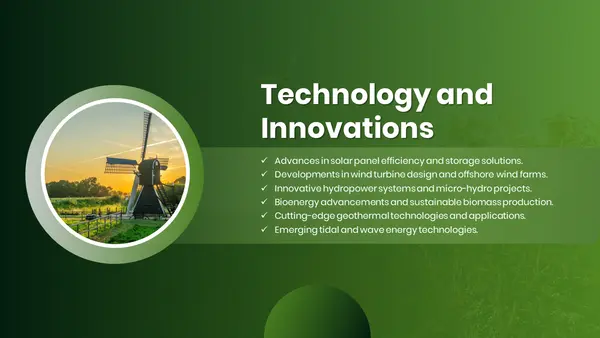
This slide of the Green Energy template highlights the technological innovations in the field of Green energy.
The field of green energy is quickly progressing with constant improvements in technology enhancing the efficiency practically and impact of renewable energy sources. Here’s a closer look at the up-to-date developments within various green energy fields:
1) Advances in Solar Panel Efficiency and Storage Solutions
Solar Panel Efficiency:
Latest developments in solar power technology have considerably upgraded the performance of solar panels developments such as perovskite solar cells that offer greater efficiency and lower production compared to conventional silicon-based cells, are at the leading edge. Scientists are also creating multi-layer cells that can gather a broader range of solar light further boosting efficiency. Additionally, Dual-sided solar panels capturing sunlight on both sides are gaining acceptance because of their increased energy output. You can download solar energy PowerPoint templates here
Storage Solutions:
Energy storage is essential for managing the irregularity of solar energy progress in energy storage technology for example lithium-ion batteries and developing solid-state batteries provide greater energy concentration and prolonged durations storage solutions are being developed to store solar energy for long durations ensuring a reliable supply despite the sun does not shine
2) Developments in Wind Turbine Design and Offshore Wind Farms
Wind Turbine Design:
Wind turbine technology has witnessed major upgrades in each design and effectiveness. Newer designs include bigger rotor blades which can capture more wind energy and increase overall energy production innovations in materials such as lightweight composite materials, improved longevity flexible control systems, and advanced airflow dynamics are being integrated to enhance turbine operation and reduce maintenance requirements.
Offshore Wind Farms:
Offshore wind farms are increasing the possibility for wind energy by utilizing more powerful and more steady winds at sea. Offshore wind turbines are a crucial innovation enabling setups in deeper waters in which traditional fixed bottom turbines are not practical. These particular floating platforms are designed to withstand extreme oceanic conditions and can be further away from shore to decrease optical and ecological effects.
3) Innovative Hydropower Systems and Micro-Hydro Projects
Hydropower Systems:
Traditional hydropower has been enhanced through innovative methods such as small modular hydropower systems and hydrokinetic turbines which capture energy from flowing water without the need for big dams. These technologies provide more renewable options to conventional large-scale projects reducing ecological impact and preserving river environments.
Micro-Hydro Projects:
Micro-hydro systems are small-scale hydro systems designed to produce power for single residences or modest communities. These initiatives usually utilize reduced flow rates and less extensive facilities, making them ideal for isolated or independent areas. Developments in turbine systems and minimal-impact water power solutions are rendering micro-hydro an increasingly practical choice for local power production.
4) Bioenergy Advancements and Sustainable Biomass Production
Bioenergy Advancements:
Bioenergy technology is getting better with new biofuels and biogas production methods. Newer biofuels, made from non-edible materials like farm waste and special energy crops, are a better renewable option compared to older biofuels. Also, making biofuels from algae is becoming popular because it produces a lot of fuel and needs less land.
Sustainable Biomass Production:
Renewable biomass methods are getting better at reducing environmental effects. These methods use fast-growing and high-yield plants, combined waste management systems, and improvements in biomass processing. These improvements make sure that biomass stays a practical and eco-friendly source of fuel while protecting natural resources and cutting down deforestation.
5) Cutting-edge geothermal Technologies and Applications
Geothermal Technologies:
Innovations in the geothermal era include progressing geothermal systems which use hydraulic fracturing to get entry to geothermal assets in areas with decreased herbal warmth waft. This approach expands the particular geographical availability of geothermal energy. Moreover, traits in geothermal warmness pumps are making it simpler to apply geothermal energy for home and business Heating and cooling.
Applications:
Geothermal energy is being used in quite a few packages past strength generation. For example, geothermal district heating structures offer efficient and sustainable heating for whole communities. New studies are likewise exploring the potential of geothermal strength for business approaches and direct-use programs that may similarly beautify its versatility and efficiency.
6) Emerging Tidal and Wave Energy Technologies
Tidal Energy:
The tidal power era is progressing with the improvement of extra efficient tidal flow and tidal range structures. Tidal circulation systems use underwater mills to seize the kinetic strength of shifting water, even as tidal variety systems utilize the rise and fall of tides to generate power. Innovations in turbine layout and underwater infrastructure are improving the reliability and performance of those systems.
Wave Energy:
Wave electricity technology is also advancing, with new designs that specialize in taking pictures of the strength of ocean waves extra effectively. Wave power converters, consisting of oscillating water columns and point absorbers, are delicate to improve their energy capture and conversion abilities. These technologies offer the capability for constant and predictable strength generation, complementing different renewable resources.
The rapid pace of technological improvements in inexperienced electricity is transforming the way we produce and devour strength. With ongoing innovations, these technologies will keep evolving, making renewable electricity greater handy, efficient, and included in our everyday lives.
This slide of the Green Energy Template will help you showcase cutting-edge advancements in green energy technologies, emphasizing the rapid progress and innovation in the field.
This will also help you Highlight practical examples of technological improvements, helping to illustrate the ongoing evolution of green energy solutions.
-
Environmental Impact (Slide 09)
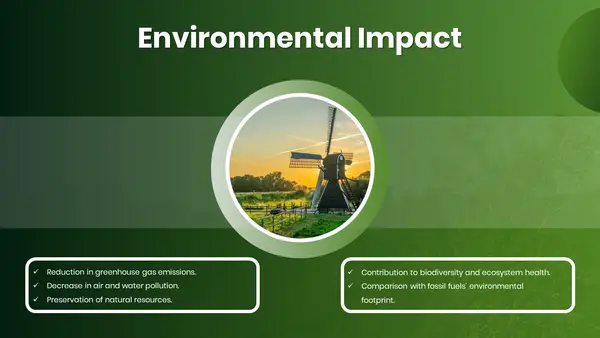
This slide on the Power of green energy Templates serves you with the impact of green energy on the environment and the challenges
Green strength assets commonly have a lower environmental impact as compared to fossil fuels. They lessen greenhouse gas emissions, lower air, and water pollutants, and minimize land degradation. However, they’re now not without their challenges. For example, massive sun farms and wind generators can disrupt local wildlife habitats, while hydropower initiatives can adjust aquatic ecosystems.
This slide Green Energy Templates Provides you with a balanced view of green energy’s environmental benefits and challenges and Encourages a comprehensive understanding of the impact of green energy projects on ecosystems.
Market Analysis Trends (Slide 10)
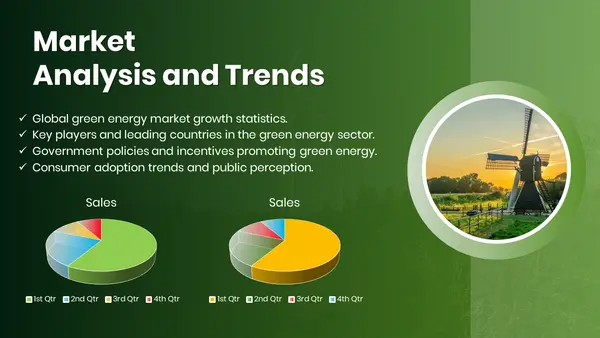
This slide Green Energy Template contains info about the market analysis and trends. This slide describes the statistics of global green energy market growth statistics, leading countries in the field of green energy, government policies, and consumer adoption.
- Global Green Energy Market Growth Statistics
This worldwide green energy sector is expanding with investments increasing due to growing ecological awareness and technological developments. Recent studies reveal a notable Compound annual growth rate(CAGR) driven by rising demand for green energy solutions and reducing expenses of renewable innovations.
- Key Players and Leading Countries in the Green Energy Sector
Key players in the field of the green energy sector include major companies like Siemens, Vestas, and Tesla whereas top countries are China, USA, and Germany. These countries are at the leading edge in the field of sustainable energy development innovations and policy development.
- Government Policies and Incentives Promoting Green Energy
Governments worldwide are implementing encouraging policies and offering incentives such as tax deductions, financial Aid, and funds to increase eco-friendly adoptions. These actions intend to reduce pollutants. Support renewable energy projects and accelerate the shift to eco-friendly energy resources.
- Consumer Adoption Trends and Public Perception
Customer adoption of eco-friendly energy is increasing. Driven by increased ecological awareness and reduced expenses. The public view is generally positive with an increasing number of individuals and companies accepting green energy solutions. As a means to contribute to Eco-friendliness and reduce carbon emissions.
This slide of the Green Energy template offers you insights into the economic and market dynamics of green energy.
Highlights the role of key players and supportive policies in driving growth.
Illustrates public and consumer trends, enhancing understanding of market momentum.
Advantages and Disadvantages of Green Energy (Slide 11)
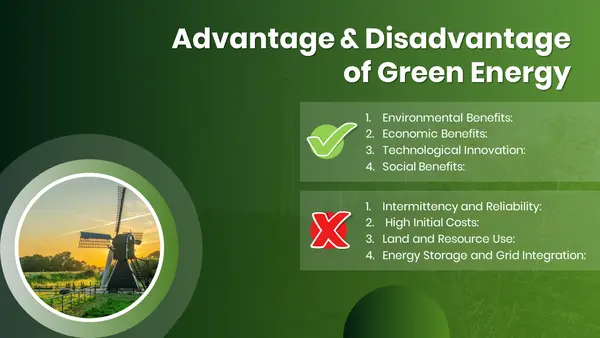
This slide Green Energy template offers advantages such as Environmental benefits, economic growth, energy independence, and technological innovation and disadvantages such as intermittent, high initial costs, land and resource use, and challenges with energy storage and grid integration.
Advantages
- Environmental Benefits:
Renewable electricity decreases greenhouse gas emissions and pollutants leading to purifier air and water. Reducing dependence on non-renewable electricity resources facilitates the combat of global warming and encourages the recovery of ecosystems leading to ordinary environmental well-being and biodiversity conservation.
- Economic Benefits:
investing in renewable energy generates job opportunities and boosts financial growth through new industries and technologies. It can reduce energy expenses over time and improve energy security by expanding energy sources and reducing reliance on imported energy sources.
- Energy Independence:
Renewable energy projects can improve local well-being by offering cleaner energy and reducing health threats related to pollution. They also encourage energy access in underserved areas and encourage public involvement and empowerment through local project engagement.
- Technological Innovation:
This effort in favour of energy drives development in technology resulting in more effective and economical energy solutions. Innovations in energy production storage and grid management improve the overall energy framework and encourage additional tech growth.
Disadvantages
- Intermittency and reliability
Some inexperienced strength sources, along with sun and wind, are intermittent and dependent on weather situations, posing challenges for a steady energy supply.
- High Initial Costs:
The premature costs of inexperienced strength infrastructure may be excessive, although they are regularly offset through long-term savings and government incentives.
- Land and Resource Use
Large-scale inexperienced strength tasks, like wind farms and sun arrays, require sizable land and sources, doubtlessly impacting neighborhood ecosystems.
- Energy Storage and grid integration
Efficient electricity storage makes it hard to deal with the intermittency of renewable electricity resources and ensure a dependable electricity supply. Integrating renewable power into existing energy grids provides technical challenges.
This slide on the Power of green energy template will help you highlight the advantages and disadvantages of green energy leading to better decision-making.
Challenges and Solutions to Green Energy (Slide 12)

This slide Green Energy template offers you various types of challenges and solutions in the way of green energy
- Intermittency and Reliability:
Renewable energy sources such as solar and wind are climate-reliant and can vary resulting in unpredictable power supply. This variability poses difficulty to grid reliability and requires remedies to guarantee a steady and constant energy flow.
Solution
Enhance Grid Management:
Developments in storage techniques like better-performing batteries and substitute methods such as hydroelectric storage can help resolve the variability of sustainable sources by storing extra electricity to use during periods of low production.
- High initial cost
The initial investment for sustainable energy solutions such as solar panels or windmills can be significant. This includes the expense of tools setup and infrastructure which could discourage investment despite long-term savings and ecological advantages.
Solution
Boost Financial Incentives:
Offer funds, Tax deductions, and financial support to reduce expenses, and support big projects to decrease expenses using cost efficiencies.
- Energy Storage:
Storing energy derived from sustainable sources for use during low-production phases is essential. Current retention systems such as batteries are still developing and can be costly and limited in capacity making it difficult to balance supply and demand.
Solution
Advance Storage Technologies:
Invest in advanced batteries and substitute storage methods use hybrid solutions to merge various methods and enhance efficiency.
- Grid Integration:
Incorporating sustainable energy into existing energy grids requires major improvements and modifications. The conventional grid facilities might not be suitable to deal with the distributed and variable aspects of sustainable energy sources.
Modernise Infrastructure:
Improve grid systems to manage renewable energy develop distributed production and small-scale grids to improve the grid’s adaptability and strength.
- Land and Resource Use:
Sustainable energy projects can demand significant areas of land or major natural resources which can result in land use disputes or affect local environments. Balancing energy creation alongside ecological conservation is a critical challenge.
Solution
Optimise Land Use:
Use previously distributed land and combine energy projects with other land uses. conduct Detailed effect evaluations to protect the ecosystem.
- Aesthetic and Wildlife Impact:
Renewable energy installations such as wind power plants and solar panels can impact local scenery and wildlife issues about aesthetic impact and possibly damage to wildlife demands precise planning and mitigation plans.
Solution
Minimise Impact:
Develop projects to reduce visual and environmental effects. Collaborate with local groups and experts to tackle issues and modify plans.
- Policy and Regulatory Barriers:
Inconsistent strategies and rules can obstruct the growth of eco-friendly energy. Different areas may have varying rules. Incentive and assistance systems can complicate efforts to execute and expand renewable energy projects.
Solution
Streamline Policies:
Formulate consistent policies and simplify regulatory procedures. Clear guidelines and benefits to promote sustainable energy acceptance.
This slide of the Power of Green Energy template will help you identify key challenges and offer practical solutions. This slide will also Provide actionable insights for overcoming obstacles in the adoption of green energy.
Future Outlook of Green Energy (Slide 13)
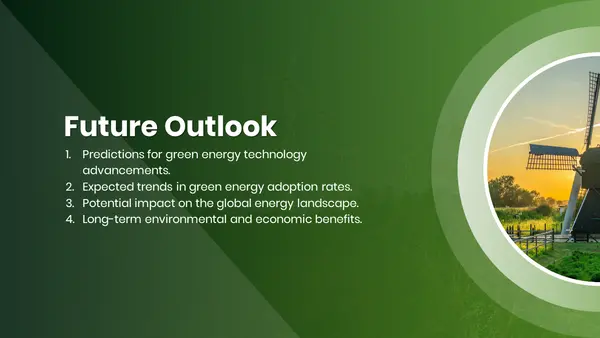
This slide Green Energy template contains a view into the future of green energy where prediction, expectations, potential impact, and long-term environmental benefits are highlighted.
The future of green energy is shining, with continued advancement and expanding worldwide commitment to economic development.
- a) Prediction for Green Energy Technology Advancements
Future developments are likely to focus on improving effectiveness, reducing expenses, and increasing the particular applicability of green energy technology innovations such as advanced solar cells, Improved windmills, and advanced energy storage solutions will play a vital role.
- b) Expected Trends in Green Energy Adoption Rates
Adoption rates are expected to progress as technology expenses drop and policy support strengthens more areas and countries are likely to establish ambitious sustainable energy goals and apply favorable policies.
- c) Potential Impact on the Global Energy Landscape
The change in the direction of green energy will substantially change the global power field resulting in reduced dependence on non-renewable energy sources. Increased energy safety and a more decentralized energy structure.
- d) Long-term Environmental and Economic Benefits
In the long run, green energy is anticipated to offer significant ecological advantages such as reduced global warming effects and improved health standards from an economic perspective. It will encourage innovations, create employment opportunities, and improve energy security.
This slide of the Green Energy template helps you to present a vision ahead of future developments and trends and Highlights the long-term potential of green energy for transforming the global energy landscape and providing environmental and economic benefits.





